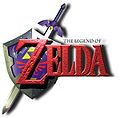| Site Notice |
|---|
|
We have a limited coverage policy. Please check our coverage page to see which articles are allowed. |
The Legend of Zelda series
| This article is a short summary of The Legend of Zelda series. Zelda Wiki features a more in-depth article. |
| The Legend of Zelda | ||||||||||||||||
| ゼルダの伝説 Zeruda no Densetsu | ||||||||||||||||
| ||||||||||||||||
| ||||||||||||||||
The Legend of Zelda (Japanese: ゼルダの伝説 Zelda no Densetsu) is a Nintendo franchise that debuted with a title on the Nintendo Entertainment System in 1986 (Japan release) and 1987 for American and European gamers. Nintendo has managed to release a title of the series for each handheld and console system released to date (with the exception of the short-lived Virtual Boy).
Shigeru Miyamoto is known to be the primary creator of the series and its characters. He has said that he was inspired by The Lord of the Rings saga and his own exploration of caves near his childhood home. Eiji Aonuma has taken lead development roles on each game since Majora's Mask, with Miyamoto taking a supervisory role.
Contents
Overview
Main games
| This section is a stub. You can help NintendoWiki by expanding it. |
Other games
Following their failed collaboration on the Super Nintendo CD add-on project, Philips still retained the rights to have Nintendo characters appear in games for the Philips CD-i. Under this deal, three The Legend of Zelda games were released by Philips Media. Link: The Faces of Evil and Zelda: The Wand of Gamelon, released simultaneously in 1993, were both developed by Animation Magic and feature Link and Zelda as the respective star characters in a side-scrolling action game similar to Zelda II: The Adventure of Link. The third game, Zelda's Adventure, was released in 1995, developed by Viridis, and features gameplay similar to other 2D The Legend of Zelda games. The three games have received widely negative reception from fans and critics, are widely considered to be non-canon to the series, and have rarely been acknowledged by Nintendo, though the games' poorly-animated cutscenes have been frequently used as a source in many remixes.
Nintendo would collaborate with Koei Tecmo to develop Hyrule Warriors, released for Wii U in 2014. The game features The Legend of Zelda characters and locations with the gameplay of Koei's Dynasty Warriors franchise. The game later received a Nintendo 3DS port, Hyrule Warriors Legends, in 2016.
Other media
Airing alongside The Super Mario Bros. Super Show! was The Legend of Zelda, a cartoon based on the first two entries in the series by DiC Entertainment, which would air on Fridays in place of the Super Mario cartoon segment. The Legend of Zelda was also the basis for a number of episodes of another DiC animated series, Captain N: The Game Master.
For the 25th and 30th anniversaries of The Legend of Zelda series, Nintendo promoted the series in various ways, including in a series of concerts/orchestras. These were available on Nintendo Video. In Japan, music pieces from the 2011 (25th anniversary) concert are available to download as a My Nintendo prize, called Zelda no Densetsu Orchestra Shuuroku Eizou: Zelda no Densetsu Main Theme (Japanese: ゼルダの伝説 オーケストラ収録映像 ゼルダの伝説 メインテーマ), Zelda no Densetsu Orchestra Shuuroku Eizou: Megami no Uta (Japanese: ゼルダの伝説 オーケストラ収録映像 女神の詩) and Zelda no Densetsu Orchestra Shuuroku Eizou: Daiyousei no Theme (Japanese: ゼルダの伝説 オーケストラ収録映像 大妖精のテーマ).
Other appearances
Link has made minor and cameo appearances in a number of other Nintendo games. Super Mario Bros. & Friends: When I Grow Up features Link on two of the game's pages. In Donkey Kong Country 2: Diddy's Kong Quest, Link appears during the Cranky's Video Game Heroes rankings in third place. In Super Mario RPG: Legend of the Seven Stars, Link can be found sleeping at the Rose Town inn after defeating Bowyer. In Super Mario 3D World, the button puzzle in Rainbow Run reveals Link's original sprite when all of the buttons are pressed and plays a rendition of the series' main theme.
A number of elements from The Legend of Zelda series have appeared in Super Smash Bros. Link has appeared as a playable character since the original game, while other series mainstays Zelda and Ganondorf were introduced in Super Smash Bros. Melee. Young Link, the child form of Link in The Legend of Zelda: Ocarina of Time, also appears as a playable character in Melee, while Toon Link, the cartoon-stylized incarnation of the character popularized by The Legend of Zelda: The Wind Waker, debuted in Super Smash Bros. Brawl. While Super Smash Bros. for Nintendo 3DS / Wii U did not introduce a new playable character from the series, it instead split Zelda and Sheik, who could previously transform between each other, into two separate characters. Other characters include minor recurring character Tingle and Ghirahim from The Legend of Zelda: Skyward Sword, who both appear as Assist Trophies. In the original game, Hyrule Castle appears as a stage. Super Smash Bros. Melee features Great Bay from The Legend of Zelda: Majora's Mask and Temple as a stage based on the series. In Brawl, the Bridge of Eldin and Pirate Ship appear as new stages. Finally, Super Smash Bros. for Nintendo 3DS features Gerudo Valley as a new stage, while Super Smash Bros. for Wii U features Skyloft. The games also feature a number of items based on items in the series, such as Heart Containers, the Bunny Hood, and Deku Nuts.
Games
Related imagery
External links
The Legend of Zelda series on other NIWA Wikis: | ||||
|---|---|---|---|---|
|
- The official home for The Legend of Zelda on Nintendo's website
- The Legend of Zelda series on Wikipedia
References
- ↑ Top Selling Title Sales Units. nintendo.co.jp. Retrieved May 29, 2019.
|
|







